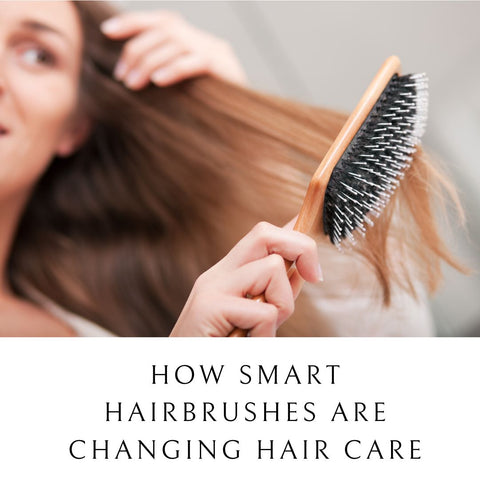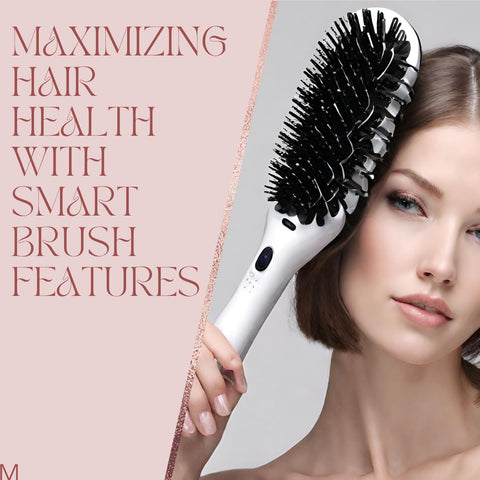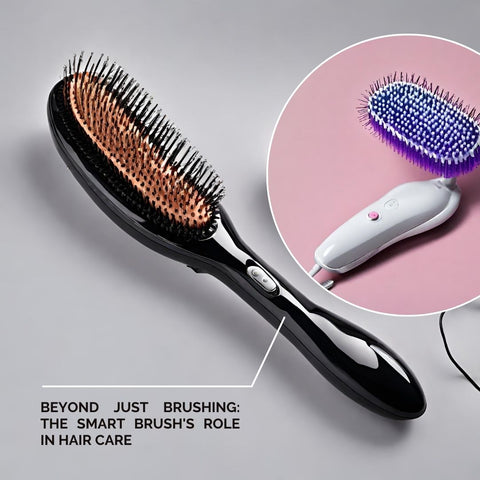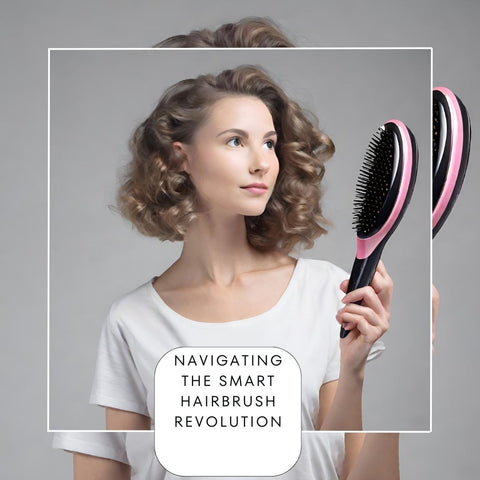The future of hair care is changing with the integration of smart brush technology, which provides innovative solutions for improving hair health. Smart brushes are designed to provide users with personalised insights and recommendations based on real-time data gathered while brushing. This blog explores how smart brush technology is influencing the future of hair care.
How Smart Hairbrushes are Changing Hair Care

Smart hairbrushes are changing the way people care for their hair by combining cutting-edge technology with personalised insights and recommendations. Here's how smart hairbrushes are transforming the hair care landscape:
-
Smart hairbrushes use sensors and technology to monitor hair health in real time. They can detect hair texture, moisture levels, scalp health, and even hair breakage as users brush their hair.
-
These brushes collect information about different aspects of hair health, such as brushing patterns, hair density, and scalp conditions. The collected information is then processed to provide useful insights into the user's hair care requirements.
-
Smart hairbrushes provide personalised recommendations for improving hair health based on the data they collect. These recommendations could include specific hair care products, styling techniques, or changes to hair care routines based on the user's specific needs and goals.
-
Smart hairbrushes recommend proper brushing techniques to reduce hair damage and increase the effectiveness of hair care products. They can detect excessive force or rough brushing and provide feedback to help users improve their brushing techniques for healthier hair.
-
Users can use smart hairbrush data to track their hair's health over time. They can track changes in hair condition and health, and adjust their hair care routines accordingly.
-
Many smart hairbrushes are compatible with mobile apps that provide detailed insights, personalised recommendations, and progress-tracking capabilities. Users can view their hair health data, set hair care goals, and receive notifications and reminders to follow their hair care routines.
-
Smart hairbrushes enhance the user experience by combining advanced technology with traditional hair care tools. They offer users valuable insights and recommendations to help them achieve healthier, more attractive hair.
The Science Behind Smart Hairbrush Technology
Smart hairbrush technology uses a variety of scientific principles and advanced sensors to assess hair health and make personalised recommendations. Here's an overview of the science behind smart hairbrush technology:
-
Sensor Technology: Smart hairbrushes include accelerometers, gyroscopes, and conductivity sensors. These sensors measure brushing force, speed, angle, and resistance, providing detailed information about brushing habits and hair condition.
-
Data Processing: The sensor data is processed using algorithms and machine learning techniques. These algorithms examine the data to identify patterns, trends, and anomalies associated with hair health, such as hair breakage, scalp condition, and brushing effectiveness.
-
Hair Health Parameters: Smart hairbrushes measure a variety of hair health parameters, including hair density, moisture levels, scalp condition, and breakage. By monitoring these parameters in real-time, smart hairbrushes can provide insights into the overall health of the hair and scalp.
-
Hair Fibre Analysis: Some smart hairbrushes use advanced imaging technology, such as microscopic cameras or fibre optic sensors, to examine individual hair fibres. This enables a thorough assessment of hair quality, including hair diameter, surface texture, and damage levels.
-
Scalp Analysis: Smart hairbrushes can also analyse the scalp for dandruff, oiliness, and inflammation. This information assists users in better understanding scalp health and identifying any underlying scalp conditions that may impact hair health.
-
Mobile Connectivity: Bluetooth and Wi-Fi connections to mobile apps are built into many smart hairbrushes. These apps give users access to information about the health of their hair, let them see personalised recommendations, let them monitor their progress over time, and send them alerts and reminders to keep up with their hair care regimens.
By combining advanced sensor technology, data processing algorithms, and machine learning techniques, smart hairbrushes offer a comprehensive solution for monitoring and improving hair health. With their ability to provide personalised insights and recommendations, smart hairbrushes are revolutionising the way people care for their hair.
Smart Brushes in Detecting Hair Damage
Smart brushes use advanced sensor technology to detect different types of hair damage. Here's how they operate:
-
Hair Strand Analysis: Smart brushes can analyse individual hair strands as they pass through them. Sensors embedded in the brush measure hair density, thickness, and elasticity. By comparing these measurements to established norms, the smart brush can identify signs of hair damage, such as thinning, breakage, and loss of elasticity.
-
Split End Detection: Some smart brushes include microscopic cameras or fibre optic sensors to detect split ends. These sensors take high-resolution images of individual hair strands, enabling the smart brush to detect split ends and other types of hair damage. Users can then receive alerts or notifications indicating the presence of split ends and take the necessary steps to resolve the issue.
-
Brushing Force Analysis: Smart brushes can measure the force applied to the hair while brushing. Excessive brushing force can damage the hair cuticle, resulting in breakage and split ends. By monitoring the brushing force in real-time, smart brushes can provide feedback to users, encouraging them to adjust their brushing technique to minimise damage.
-
Moisture Level Monitoring: Changes in hair moisture levels may indicate damage or dehydration. Smart brushes may include sensors that measure hair moisture levels as they pass through the hair. By tracking moisture levels over time, the smart brush can detect patterns of dehydration and recommend appropriate hair care products or treatments to restore moisture balance.
-
Scalp Health Assessment: Healthy hair begins with a healthy scalp. Smart brushes can evaluate scalp health by measuring oiliness, dryness, and inflammation. Signs of scalp issues, such as dandruff or scalp irritation, can indicate underlying hair damage. By monitoring scalp health, smart brushes can provide insights into potential causes of hair damage and recommend targeted treatments to improve scalp conditions.
Advancements in Hair Health Monitoring
Advances in hair health monitoring have resulted in innovative technologies and tools that enable a more accurate and comprehensive assessment of hair conditions. Here are some recent developments in this field:
-
Smart Hairbrushes: Equipped with sensors and artificial intelligence, smart hairbrushes can analyse brushing patterns, hair texture, scalp condition, and other parameters to provide real-time hair health information. These brushes can detect damage, such as split ends and breakage, and provide personalised recommendations for better hair care routines.
-
Microscopic Imaging: Advanced imaging techniques like trichoscopy and optical coherence tomography (OCT) enable detailed visualisation of the scalp and hair follicles. These imaging techniques can detect hair and scalp conditions such as hair loss, scalp inflammation, and follicle miniaturisation with high resolution and accuracy.
-
Hair Analysis Devices: There are more and more portable devices available that can analyse hair samples for moisture content, structural integrity, and nutrient levels. These tools evaluate the health of the hair and spot deficiencies or anomalies that might be causing damage or hair loss. They do this by using spectroscopy, chromatography, and other analytical techniques.
-
Digital Health Platforms: Users can track their hair care routines, set goals, and receive personalised recommendations based on their individual needs and preferences by using online platforms and mobile apps dedicated to hair health monitoring. These platforms may combine user input, data from smart devices, and scientific research to offer all-inclusive hair care solutions.
-
Biomarker Detection: Studies on biomarkers linked to hair pathology and health are improving our knowledge of the biology of hair. Targeted diagnostic and therapeutic approaches can be made possible by identifying molecular signatures associated with specific hair conditions using biomarker detection methods such as transcriptomics and proteomics.
-
Artificial Intelligence (AI) Algorithms: AI algorithms trained on large datasets of hair health information can analyse complex patterns and correlations to identify predictive factors for hair loss, breakage, and other issues. These algorithms can help clinicians and researchers develop more accurate diagnostic tools and personalised treatment plans for individuals with hair disorders.
-
Wearable Sensors: Wearable sensors integrated into clothing or accessories can monitor environmental factors, such as UV exposure, humidity, and pollution, that may impact hair health. By tracking these variables, wearable sensors can provide insights into external factors that contribute to hair damage and guide users in adopting protective measures.
Maximizing Hair Health with Smart Brush Features

Maximizing hair health with smart brush features entails using the devices' advanced capabilities to monitor, analyse, and improve various aspects of hair care. Here's how you can use smart brush features to improve your hair health:
-
Use smart brushes' real-time monitoring capabilities to keep track of your brushing habits, hair texture, and scalp condition. Regular monitoring allows you to identify patterns, trends, and potential issues with your hair's health.
-
Smart brushes provide personalised recommendations, allowing you to tailor your hair care routine to your specific needs and goals. These recommendations may include suggestions for appropriate hair care products, brushing techniques, and lifestyle changes that will improve hair health.
-
Use smart brush features to identify signs of hair damage, such as split ends, breakage, and dryness. Pay attention to alerts or notifications from the smart brush that indicate areas of concern, and take appropriate action to address hair damage right away.
-
Use the scalp analysis features provided by smart brushes to evaluate scalp health and identify potential scalp issues, such as dandruff or inflammation. Make changes to your hair care regimen and take care of any scalp issues that could affect the health of your hair by using the information provided here.
-
Follow the instructions provided by smart brushes to improve your brushing technique and reduce hair damage. Pay attention to feedback on brushing force, speed, and angle, and adjust your brushing habits accordingly to keep your hair from being stressed and damaged.
-
Smart brushes collect data that can be used to track your hair's health over time. Monitor changes in hair condition, scalp health, and brushing habits to determine the effectiveness of your hair care routine and make necessary adjustments.
-
Connect your smart brush to a mobile app to gain access to advanced features like detailed insights, progress tracking, and personalised recommendations. Use the app from anywhere, at any time, to review your hair health data, set goals, and receive advice on how to improve your hair health.
You can improve your hair care routine and hair health by making the most of smart brushes' features. Make use of these devices' advanced capabilities to monitor, analyse, and improve various aspects of hair care, resulting in healthier, more vibrant hair.
Utilizing Smart Brushes for Split End Detection
Using smart brushes for split end detection can help you identify and treat hair damage quickly, preventing further breakage and promoting healthier hair. Here's how to effectively use smart brushes for split-end detection:
-
Brush regularly: Use a smart brush to incorporate regular brushing sessions into your hair care routine. Brushing your hair gently and consistently distributes natural oils, detangles knots, and aligns hair strands, making split ends easier to detect.
-
Pay Attention to Alerts: Many smart brushes come equipped with sensors that can detect signs of hair damage, such as split ends. As you brush your hair, pay attention to the smart brush's alerts or notifications that indicate the presence of split ends.
-
Inspect Hair Strands: Some smart brushes have magnifying or zoom features that allow you to examine individual hair strands more closely. Inspect your hair's ends for visible signs of splitting, fraying, or damage.
-
Use Visual Aids: Some smart brushes include cameras or LED lights that provide visual feedback on hair condition. Take advantage of these features to examine your hair more closely and identify split ends faster.
-
Track Split End Patterns: Using the data collected by the smart brush, keep track of where and how often split ends occur. Look for patterns or trends that may indicate which areas of your hair are more vulnerable to damage, allowing you to focus on targeted treatments and preventative measures.
-
Follow Recommendations: Follow any recommendations or suggestions made by the smart brush for addressing split ends and preventing future damage. This may include trimming your hair's ends regularly, using protective styling techniques, and incorporating nourishing hair care products into your routine.
-
Adjust Your Hair Care Routine: Based on the information gathered from split end detection, make any necessary changes to your hair care routine. Avoid using harsh styling tools or excessive heat on your hair, and instead use conditioning treatments or hair masks to keep it hydrated and nourished.
By using smart brushes to detect split ends, you can stay proactive in maintaining healthy hair and preventing further damage. Paying attention to alerts, inspecting hair strands, and following the smart brush's recommendations will help you keep your hair looking great.
Preventing Hair Breakage with Intelligent Brushing
Intelligent brushing prevents hair breakage by implementing techniques and habits that reduce stress on the hair strands while effectively detangling and styling. Here's how intelligent brushing can help prevent hair breakage:
-
Choose the Right Brush: Look for a brush with soft, flexible bristles that glide smoothly through the hair without pulling or snagging. Avoid brushes with sharp edges or metal bristles, as they can damage the hair cuticle and cause breakage.
-
Start at the Ends: Brush your hair from the ends up to the roots. This helps to gently detangle knots and reduces pulling on the hair strands, lowering the likelihood of breakage.
-
Use Gentle Strokes: To prevent undue stress on the hair shaft, brush your hair with soft, flowing strokes. Avoid vigorous brushing or pulling, as it can weaken the hair and cause breakage over time.
-
Detangle with Care: Gently remove knots and tangles from your hair using a wide-tooth comb or detangling brush. To prevent pulling or breaking the hair, begin at the bottom of the tangle and work your way up gradually, using short, light strokes.
-
Brushing Wet Hair: Wet hair is more prone to breakage, so avoid brushing it right after washing. Instead, gently detangle wet hair with a wide-tooth comb or your fingers, then use a brush once it is partially dry.
-
Protective Styling: When styling your hair, choose protective styles that reduce tension and manipulation, such as loose braids, buns or ponytails. Avoid tight hairstyles and elastic bands, which can cause breakage.
-
Use Heat Protectant: Before using heat styling tools, always apply a heat protectant spray or serum to your hair. This helps to form a protective barrier against heat damage and lowers the likelihood of breakage and split ends.
-
Trim regularly: Every 6-8 weeks, trim your hair to remove split ends and keep them from travelling up the shaft. This helps to keep your hair healthy and reduces the likelihood of breakage.
-
Maintain a Healthy Diet: Eat a well-balanced diet high in nutrients that promote hair health, such as vitamins A, C, E, and biotin. Drinking plenty of water and staying hydrated also promotes hair strength and resilience.
By incorporating these intelligent brushing techniques into your hair care routine, you can help prevent hair breakage while also keeping your locks looking healthy and vibrant.
Personalizing Hair Care with Smart Brush Analytics
Personalising hair care with smart brush analytics entails using the data collected by smart brushes to tailor your hair care routine to your specific needs and objectives. Here's how to use smart brush analytics to personalise your hair care routine:
-
Monitoring Hair Health: Use the smart brush's data, such as brushing patterns, hair texture, and scalp condition, to track the overall health of your hair. Look for trends or changes in hair health over time and make adjustments to your hair care routine accordingly.
-
Identifying Problem Areas: Examine the smart brush data to determine any problem areas or areas of concern, such as excessive hair breakage, scalp dryness, or split ends. Pay attention to any alerts or notifications from the smart brush that indicate areas that may require attention.
-
Setting Goals: Determine specific hair care objectives based on your hair health data and desired outcomes. Whether you want to reduce hair breakage, improve scalp health, or improve hair texture, use the smart brush's insights to set realistic goals that meet your needs and preferences.
-
Receiving Recommendations: Take advantage of the smart brush's personalised recommendations to improve your hair care routine. These recommendations may include suggestions for appropriate hair care products, brushing techniques, and lifestyle changes based on your specific hair care needs.
-
Tracking Progress: Use the smart brush's data to track your progress towards your hair care goals. Monitor changes in hair health metrics, such as less breakage, better scalp condition, or improved hair texture, and celebrate your progress along the way.
-
Adjusting Your Routine: Use the information gleaned from smart brush analytics to make informed changes to your hair care routine. Whether it is changing your shampoo and conditioner, adding a weekly hair mask, or adjusting your brushing technique, tailor your routine to address any issues identified by the smart brush.
-
Experimenting with Treatments: Use the smart brush's recommendations to try out different hair care treatments and products. Try new treatments, such as deep conditioning masks or scalp treatments, to address specific hair care needs and achieve the best results.
You can take a proactive approach to maintaining healthy, beautiful hair by personalising it with smart brush analytics. Use the smart brush's insights to tailor your hair care routine to your specific needs and goals, and reap the benefits of a customised approach to hair care.
Beyond Just Brushing: The Smart Brush's Role in Hair Care

Beyond brushing, smart brushes play a multifaceted role in hair care by providing a variety of features and capabilities that exceed traditional brushing. Here's how smart brushes can improve different aspects of hair care.
-
Smart brushes contain sensors that analyse various aspects of hair health, such as moisture levels, scalp condition, and hair texture. By monitoring these metrics, smart brushes provide insights into the overall health of the hair and scalp, helping users identify areas of concern and track progress over time.
-
Smart brushes use advanced sensor technology to detect signs of hair damage, such as split ends, breakage, and dryness. By alerting users to potential problems, smart brushes allow for proactive intervention to address hair damage and prevent further deterioration.
-
Based on the information gathered, smart brushes provide personalised recommendations for improving hair health and optimising hair care routines. These recommendations may include suggestions for appropriate hair care products, styling techniques, and lifestyle changes based on the user's specific needs and goals.
-
Smart brushes guide proper brushing technique, reducing hair damage and increasing the effectiveness of hair care products. By analyzing brushing patterns and providing real-time feedback, smart brushes help users brush their hair more effectively and gently, reducing the risk of breakage and split ends.
-
Many smart brushes are compatible with mobile apps, allowing users to gain detailed insights, track progress, and receive personalised recommendations while on the go. Users can view their hair health data, set goals, and follow guided routines to improve their hair care regimen and achieve healthier, more beautiful hair.
-
Smart brushes are educational tools that teach users about hair care techniques, hair anatomy, and common hair problems. By raising awareness and promoting good hair care habits, smart brushes empower users to take better care of their hair and scalp.
-
Smart brushes improve the overall hair care experience by offering advanced features and an easy-to-use interface. By offering convenience, customization, and real-time feedback, smart brushes make it easier for users to maintain healthy, beautiful hair from the comfort of their own homes.
Innovative Solutions for Hair Health Challenges
Innovative solutions to hair health issues are constantly emerging, leveraging technology, scientific advancements, and holistic approaches to address a variety of hair concerns. Here are some innovative solutions to common hair health challenges:
-
Scalp Health Monitoring Devices: Sensing-equipped wearable devices for monitoring scalp health can measure issues like inflammation, dryness, and oiliness. These gadgets support healthier hair development by giving users access to real-time data and insights that enable them to recognise scalp problems early and take proactive measures to correct them.
-
Personalised Hair Care Products: Advances in personalised hair care technology enable the development of customised hair care products based on individual hair types, concerns, and preferences. Personalised hair care formulations use factors such as hair texture, porosity, and scalp condition to deliver targeted ingredients and treatments that improve hair health and address specific concerns.
-
Nutritional Supplements: Supplements designed specifically for hair health can supply essential vitamins, minerals, and nutrients to promote strong, vibrant hair growth. Innovative supplements may contain biotin, collagen peptides, and adaptogenic herbs that nourish hair follicles, improve hair texture, and promote overall hair health from within.
-
Scalp Microbiome Products: New research on the scalp microbiome has resulted in the development of innovative hair care products that promote a healthy scalp ecosystem. Probiotic and prebiotic scalp treatments help balance the scalp microbiome, reduce inflammation, and promote optimal hair growth, providing a natural solution for scalp health issues.
-
Low-Level Laser Therapy (LLLT): Devices like laser hair combs and helmets use low-level laser technology to stimulate hair follicles, increase blood flow to the scalp, and promote hair growth. Clinical trials have shown that LLLT can significantly improve hair density, thickness, and overall hair health, making it a non-invasive treatment option for hair loss and thinning.
-
Stem Cell Therapy: Stem cell therapy uses stem cells' regenerative potential to stimulate follicle regeneration and promote hair growth. Platelet-rich plasma (PRP) therapy and stem cell injections are two innovative techniques that deliver concentrated growth factors and stem cells to the scalp, rejuvenating hair follicles and improving hair density and quality respectively.
-
AI-Powered Hair Analysis Apps: Mobile apps powered by artificial intelligence (AI) analyse images of users' hair and scalps to provide personalised hair analysis and recommendations. These apps can evaluate hair condition, identify potential problems, and recommend personalised hair care products, treatments, and styling techniques to address specific concerns and achieve desired hair results.
Individuals can use these innovative solutions to address common hair health issues, optimise their hair care routines, and achieve healthier, more beautiful hair.
The Integration of AI in Hair Care Regimens
The use of artificial intelligence (AI) in hair care regimens is changing the way people approach and manage their hair health. Here's how AI is being implemented in various aspects of hair care:
-
Personalised Product Recommendations: AI-powered algorithms use user data, such as hair type, concerns, and preferences, to generate tailored product recommendations. By considering factors like hair texture, scalp condition, and environmental factors, AI can suggest the most suitable shampoos, conditioners, treatments, and styling products for individual needs.
-
Virtual Hair Consultations: AI-powered virtual assistants and chatbots offer users personalised hair care recommendations and consultations. These virtual assistants can answer questions, make recommendations, and provide guidance on topics like hair styling, maintenance, and problem-solving, making expert advice available at any time and from any location.
-
Smart Hairbrushes and Devices: Artificial intelligence-enabled hairbrushes analyse brushing patterns, hair health metrics, and scalp conditions in real time to provide feedback and insights. These devices can detect issues such as breakage, split ends, and scalp dryness, and provide personalised recommendations and guidance to help you optimise your hair care routine.
-
Hair Analysis Apps: AI-powered mobile apps analyse user-submitted hair and scalp images to assess hair health, identify potential issues, and recommend personalised solutions. These apps can provide information about hair density, thickness, and condition, allowing users to track progress and make informed decisions about their hair care routine.
-
Hair Growth Prediction: AI algorithms can forecast hair growth patterns and outcomes based on individual traits and treatment interventions. By analysing genetics, lifestyle, and hair health data, AI can predict hair growth potential, treatment response, and expected outcomes, assisting users in setting realistic goals and expectations for their hair care journey.
-
AI-Driven Hair Restoration Solutions: Advanced AI algorithms are being used in hair restoration treatments to optimise surgical techniques, tailor treatment plans, and improve outcomes. AI-powered tools help surgeons plan hair transplant procedures, determine graft placement, and predict postoperative outcomes, resulting in more precise and effective treatments for hair loss and thinning.
-
Continuous Improvement and Learning: As more data and user feedback are collected, AI-powered hair care platforms continue to learn and improve. By analyzing trends, patterns, and user interactions, AI algorithms can refine their recommendations, adapt to individual preferences, and enhance the overall user experience, ensuring ongoing optimization of hair care regimens.
Embracing Digital Tools for Improved Hair Care
Using digital tools to improve hair care has many advantages, including personalised recommendations, easy access to information, and improved tracking capabilities. Here are some ways to use digital tools to improve hair care:
-
Hair Analysis Apps: Use mobile apps with hair analysis features to evaluate your hair's health, identify areas of concern, and receive personalised recommendations. These apps typically analyse factors such as hair texture, density, and scalp condition to provide insights and recommendations that are specific to your needs.
-
Virtual Consultations: Use video conferencing platforms to set up virtual consultations with hair care experts or trichologists. Virtual consultations provide convenient access to professional advice and recommendations, allowing you to address specific hair concerns while receiving personalised guidance from the comfort of your own home.
-
Smart Hairbrushes: Invest in a smart hairbrush that uses sensors and AI technology to track brushing habits, detect hair damage, and provide real-time feedback. Smart hairbrushes use brushing patterns, hair health metrics, and scalp condition to provide personalised recommendations for improving your hair care routine.
-
Online Communities and Forums: To meet people who share your interests, exchange stories, and gain knowledge from others' perspectives, join online communities and forums devoted to hair care. These forums offer a helpful setting for talking about product suggestions, hair care advice, and fixes for typical hair issues.
-
Product Review Websites: Look through and compare hair care products using user reviews, ratings, and recommendations by visiting product review websites and platforms. You can make well-informed decisions when selecting hair care products that best fit your needs and preferences by reading other customers' reviews.
-
Educational Resources: Increase your understanding of hair care methods, components, and trends by utilising online resources like blogs, articles, and tutorials. Numerous trustworthy websites and online forums provide insightful information and advice from trichologists, industry professionals, and experts in hair care.
-
Apps for tracking: Make use of apps for tracking to keep an eye on your hair care regimen, evaluate your progress, and establish objectives for better hair health. These apps enable you to record information such as hair washing frequency, product usage, and styling techniques, allowing you to identify patterns and make adjustments as needed to achieve your hair care goals.
By using digital tools for better hair care, you can gain access to valuable resources, receive personalised recommendations, and track your progress more effectively, resulting in healthier, more beautiful hair.
Navigating the Smart Hairbrush Revolution

Understanding the features, advantages, and factors to take into account when using these cutting-edge hair care products is essential to navigating the smart hairbrush revolution. This book will help you take full advantage of the smart hairbrush revolution by going over topics like understanding features, selecting the best brush, discovering benefits, setting expectations, getting into a routine, tracking improvement, and seeking expert advice. Through deliberate and proactive navigation of the smart hairbrush revolution, you may leverage the advantages of these cutting-edge hair care tools to attain healthier, more beautiful hair. To get the most out of your hair care journey, be open-minded, try out various features and techniques, and stay up to date on the latest advancements in smart hairbrush technology.









































